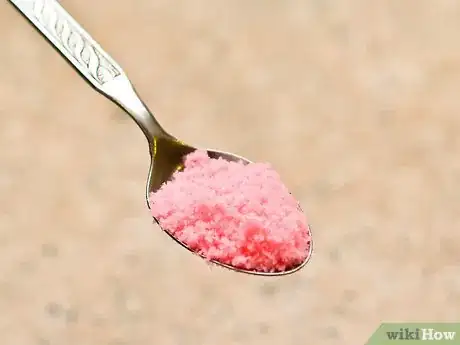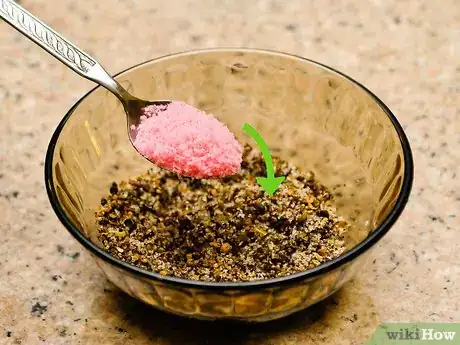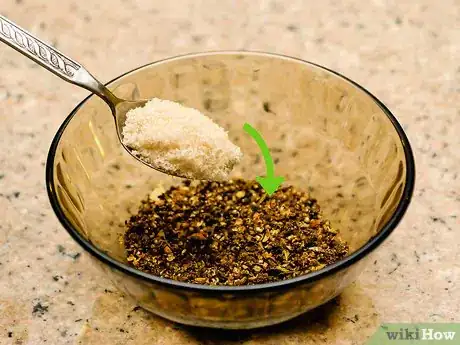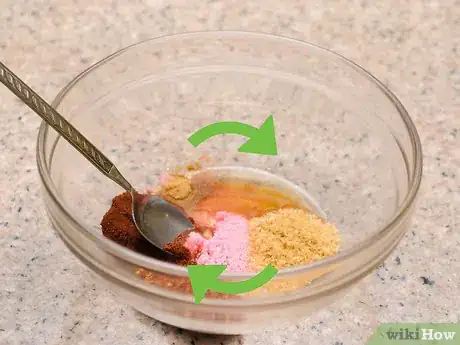This article was co-authored by wikiHow Staff. Our trained team of editors and researchers validate articles for accuracy and comprehensiveness. wikiHow's Content Management Team carefully monitors the work from our editorial staff to ensure that each article is backed by trusted research and meets our high quality standards.
There are 8 references cited in this article, which can be found at the bottom of the page.
This article has been viewed 83,105 times.
Learn more...
Curing bacon yourself might seem like a lot of labor when you can just go to the supermarket and pick up a package that is ready to cook as is. However, curing the meat yourself allows you to omit sodium nitrites if desired, as well as tailor the flavor to your exact preferences!
Steps
Prepping the Meat
-
1Buy a fresh pork belly. For the best texture and taste, insist on meat that is organic and/or free of artificial hormones.[1] Specify that you want a raw pork belly that hasn't already been cured or sliced. For a fattier bacon, ask for meat that came from the hog's belly and/or chest. For a meatier bacon, ask for meat that covered the hog's spare ribs.[2]
- Whole pork bellies typically weigh between 10 and 12 pounds, but if you are experimenting with cure recipes, ask for a smaller cut in case you end up not liking your concoction.
-
2Chill your meat. If you purchased your pork belly from a commercial vendor other than a farm and plan on curing it as soon as you get home, skip this step, since the meat has already been chilled. But if you buy direct from a farm, ask the farmer how long ago the hog was slaughtered, because you need to chill your meat within 24 hours of that time. In either case, bring along a cooler stocked with ice to keep the pork belly relatively cool on the ride home if it takes you more than half an hour.[3]
- Once home, place the pork belly in a sealable container to keep your fridge clean and prevent cross-contamination with other items.
- For a quicker chill, set the container inside the fridge wherever it is coldest. To further reduce the chance of cross-contamination, set it in the meat compartment, away from other products.
- Keep the refrigerator's temperature at 40 degrees Fahrenheit and let the pork belly sit until its core temperature drops to 42 degrees, which will help kill bacteria.
- If you are chilling multiple bellies, set each one in its own container rather than stacking the meat directly on top of each other.
Advertisement -
3Cut the skin off. Either ask your butcher to do it for you when you purchase the meat, or do it at home yourself. In the latter case, use a sharpened knife since the skin is tough. Begin your cut at any corner of the belly. As you slice the skin off, angle the blade toward the skin, rather than away from it, so you don't end up trimming off any more precious meat than necessary. Once your skin is removed, the meat will absorb more of the cure.[4]
- The discarded skin can be cooked on its own, either by grilling or deep-frying. If you wish to do this, be sure to tell your butcher to save the skin if you have them slice the skin off for you.
Creating Various Cures
-
1Decide on a curing agent. Buy curing salts online if they aren't available at your local supermarket or butcher's. Or, mix your own using kosher salt and sodium nitrite, which is also available online. However, be aware that there has been debate about sodium nitrite (the principal preservative in curing salt) and its possible link to cancer and other diseases,[5] due to its possible conversion into carcinogenic nitrosamines. Use celery powder or ground celery seeds as an alternative if this is a concern.
- Be aware, though, that such alternatives do contain sodium nitrate. There is also some debate about whether sodium nitrate is any healthier than sodium nitrite. The argument for using celery products is that the presence of certain vitamins and minerals is believed to prevent the conversion of nitrates into harmful nitrosamines.
-
2Mix a basic cure. Exact recipes vary by personal taste and ingenuity. To cure 5 pounds of meat with a minimum of ingredients, first combine 1 cup of sugar with 2 tablespoons of blackstrap molasses in a bowl. Stir thoroughly. Then add 4 tablespoons of kosher salt, 2 teaspoons of curing salt, and 2 teaspoons of ground black pepper. Mix thoroughly, taste, and add more salt if desired.[6]
- Even this basic recipe can be altered to suit your tastes by exploring the effects of different types of sugar, salt, and pepper.[7]
-
3Try a saltier cure with sage and thyme. For roughly 5 pounds of meat, combine a ½ cup of kosher salt with 2 teaspoons of sodium nitrite. Mix in a ¼ cup of brown sugar (either dark or light is fine). Then add ⅛ cup of each of the following: ground black pepper, ground juniper berries, and crumbled sage. Finally, add 1 tablespoon of dried thyme. Stir all ingredients thoroughly for an even mix.
- Both the sodium nitrite and juniper berries can be omitted if desired.
-
4Cure your bacon with honey. For every 5 pounds of meat, combine a ¼ cup of kosher salt with 2 teaspoons of pink curing salt. Then add a ¼ cup of dark brown sugar. Next, add spices: 2 tablespoons of red pepper flakes, 2 tablespoons of smoked sweet paprika, and 1 teaspoon of cumin seeds. Lastly, pour a ¼ cup of honey into the dry ingredients and stir them together until both wet and dry ingredients have been evenly mixed.[8]
- Any honey will do, but chestnut honey works particularly well here.
Curing Your Pork Belly
-
1Rub the cure into the meat. Remove your chilled pork belly from the fridge. To keep your kitchen surfaces clean, place it on a rimmed baking sheet. Coat the meat with your cure recipe. Then massage the cure into the meat all over,[9] doing your best to spread the cure over and into the pork belly as evenly as you can for consistent flavor.
-
2Refrigerate the pork belly. Once it has been coated with cure, place the meat into a sealable container. If you use a plastic bag for this, set the bag in a rimmed baking sheet or a pan to keep any possible leaks from spreading in your fridge. Refrigerate the pork belly for at least 5 days. As juices begin to pool at the bottom of the container, be sure to flip the pork belly daily so each side is more or less evenly soaked in brine.[10]
- If your meat is particularly thick, or you wish to have as much cured flavor as possible, leave the pork belly to cure for 7 days to ensure that the cure makes its way to the middle of the meat, thus extending its shelf life.
-
3Rinse your meat. Remove the pork belly from the fridge and its container. Place it in a colander. Run cold water over both sides to wash away all excess salt. Then use paper towels or a clean towel to gently pat the meat dry.[11] Your bacon is now cured!
-
4Store your meat safely. If you do not cook and consume your bacon right away, wrap it with plastic wrap. Seal it tightly to keep out air.[12] Store in your refrigerator or freezer.
- Bacon slabs cured with nitrites will last 4 to 6 weeks in the refrigerator and 3 months in the freezer.[13]
- Bacon slabs cured without nitrites will last 3 weeks in the refrigerator and 6 months in the freezer.
-
5Finished.
Things You'll Need
Supplies
- Raw, chilled pork belly
- Ice cooler for transport (optional)
- Sharp knife
- Sealable container
- Refrigerator
- Colander
- Cold water
- Rimmed baking sheet, roasting pan, or similar item
Ingredients for Basic Cure (for 5-lb. pork belly)
- 1 cup sugar
- 2 tablespoons blackstrap molasses
- 4 tablespoons kosher salt
- 2 teaspoons curing salt
- 2 teaspoons ground black pepper
References
- ↑ http://barbecuebible.com/recipe/8-steps-making-bacon-home/
- ↑ http://amazingribs.com/recipes/porknography/making_bacon_from_scratch.html
- ↑ http://meatsafety.org/ht/d/sp/i/26023/pid/26023
- ↑ http://barbecuebible.com/recipe/8-steps-making-bacon-home/
- ↑ http://healthyeating.sfgate.com/harmful-effect-sodium-nitrite-food-11184.html
- ↑ http://www.splendidtable.org/recipes/curing-your-own-bacon
- ↑ http://barbecuebible.com/recipe/8-steps-making-bacon-home/
- ↑ http://www.foodnetwork.com/recipes/homemade-bacon.html
- ↑ http://barbecuebible.com/recipe/8-steps-making-bacon-home/
- ↑ http://barbecuebible.com/recipe/8-steps-making-bacon-home/
- ↑ http://barbecuebible.com/recipe/8-steps-making-bacon-home/
- ↑ http://essentialstuff.org/index.php/2012/06/09/Cat/curing-meats-at-home/comment-page-1/
- ↑ http://www.fsis.usda.gov/wps/portal/fsis/topics/food-safety-education/get-answers/food-safety-fact-sheets/meat-preparation/bacon-and-food-safety/ct_index
About This Article
To cure bacon, start by making a curing agent with kosher salt and sodium nitrite. You can also use celery powder as a curing agent. Next, create your cure by adding seasonings like salt, pepper, thyme, and sugar to your curing agent. Mix everything together and then rub your cure onto the outside of the bacon. Once you've covered the bacon, put it in a sealable plastic container and set it in the fridge for 5 days to cure. After 5 days, rinse off the bacon, wrap it in plastic wrap, and store it in the freezer for several months. If you want to learn different flavors and seasonings for your cure, such as honey or sage, keep reading!































































